Diablo IV Hands-on: Redemption by blood, horror and fun
We've played Diablo IV, and any worries we had are gone. Here's what to expect from the gameplay, horror, and gore in Blizzard's upcoming title.
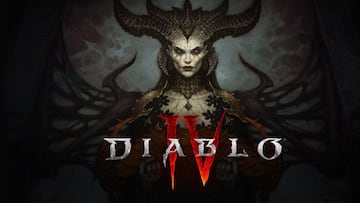
Being a Diablo fan is a complicated thing to be in 2022. But it’s about to get much easier. A few days ago, Blizzard Entertainment invited MeriStation and other members of the press to a closed test of an in-development build of Diablo IV.
Announced originally during BlizzCon 2019 with a short trailer, Diablo IV has had scarce updates and news since then, leaving hardcore followers anxious, and imaginations running wild. After Diablo Immortal’s release, everything pointed to a terrible situation and hope seemed to have vanished. Having played this very early version, we can assure you that this is not the case. So long as the design values and goals of the team stay the same, we might be dealing with the quintessential Diablo experience here: what it was always meant to be.
The World of Sanctuary… has seen some S**t
Without going into any spoilers, the game is set some time after the events of Diablo III and its expansion, Reaper of Souls. Humanity has been decimated and is now fighting for survival, with civilization having shifted almost completely. And as the reveal trailer suggested, the demon Lilith, creator of Sanctuary, is coming back to mess things even further with strange plans.
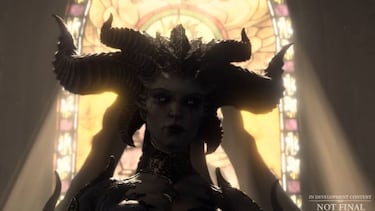
However, from just the initial hours of Diablo IV it is very clear that this isn’t a simple “good vs evil” story: yes, you’re fighting demons, but in what is basically a post-apocalyptic world of angels and demons, the lines have been blurred quite a bit. There’s big mysteries going on everywhere, and in this entry of the series the plot is at the forefront of the experience. At least, if that’s what you’re looking for.
Marketed as “open world” the developers have spent the last few years telling us about how different this experience is to previous games in the franchise. We can understand how this works on the gameplay side of things (big maps, freedom to explore, side missions, etc…), but how would that translate to the typically linear story? Well, the Act-based format from before is technically still here, but there is non-linear campaign progression that allows you to advance the plot as you wish to do.
There is an order to how things happen, but almost from the start the developers give you the option to play whatever mission you have unlocked in whatever order you wish. Characters roam around the world, each one with different goals, and it’s your choice of when to go with them. You can choose to do Act I quests, or travel to a different region to complete ACT III with a different ally, only to come back later and continue with the plot quests at a later time. And it works! The setting is a world-spanning adventure, and you’re set to explore every inch of it with almost complete freedom.
Speaking with the lead designers of the game, we discovered that there are some systems set in place to allow for all of this: there will be some level scaling to ensure there is always a challenge, for example, and certain zones might still be too difficult for a new adventurer to survive in, but they’ve been preparing to fulfill their open-world ambitions for a long time, and it shows.
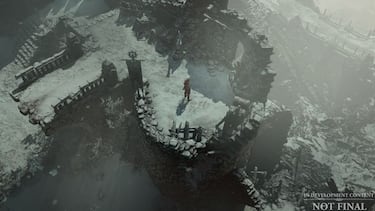
We were only able to explore one of the five zones that’ll be available in the full game, a snowy area known as the Fractured Peaks. And yet this one area had enough content to keep us engaged for a whole week. We’re talking about full scaled dungeons, tons of loot, world events and bosses to challenge alongside other players, and more. Every corner of the overworld is filled with things to discover, apart from tons of loot and unforgiving dungeons to delve into.
Speaking of difficulty, the World Tiers of Diablo III are back, except this time you get the chance to switch them up in the middle of your playthrough. The first Tier of this difficulty system is perfect for newer players, meaning they won’t have too much trouble getting through the campaign and learning the ropes. However, it is recommended that if you’re a Diablo veteran you begin from Tier II and build your way up to the higher levels. And you might already imagine how it works: the higher the World Tier, the tougher the monsters are. Their levels increase and they start demanding more skill and better gear, but as a reward every piece of loot dropped is also much more powerful.

Every skill comes with a free dead demon!
The playable characters are also the best they’ve ever been. The new skill tree system is packed full of options to customize the way each of the classes works, giving you the freedom to explore and experiment with different abilities and upgrades to create a build that fits your gameplay style. Looking like a tangle of roots, each node of the tree allows you to pick and choose from a variety of skills for your attacks. Every Skill Point you spend counts towards unlocking the next node, and with it even more abilities to choose from. Thankfully, you can refund skill points and redo your selections at any time.
This time however, every skill lets you choose a “specialization”, an upgrade that may alter how an ability works at a fundamental level. To give an example, playing as the Rogue you get your basic resource builder (two options for melee attacks, three for ranged), then get to choose a basic spender (a skill that roots an enemy and deals big damage, a flurry of melee attacks, a spread shot with a bow or crossbow, or one powerful piercing shot). The next tier starts giving you more tools to play with, such as a teleporting back stab, a dash that goes through enemies, or a backflip that puts you out of danger and leaves a trap on the ground that deals Area of Effect damage. This is all a very simplified explanation of the system, but hopefully it helps to explain that there are plenty of options to play with, and that unless you’re following a guide, your experience may be completely different from another player’s even if you’re playing the same class.
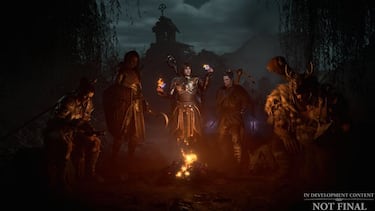
During our time with the game, we were only able to play as the Barbarian, the Sorcerer, and the aforementioned Rogue. All of them are returning characters from previous titles in the series, but even so they feel fresh and unique. Yes, you can still make your Barbarian a hulking, spinning whirlwind of death, but there’s also options to choose from when you want to try something new (for about 15 minutes, before deciding that you need to keep spinning. It’s ok, we do it too). All of this is to say that the classes have retained their essence, but they’re not locked to nostalgia. They all feel renewed and flexible, and we can’t wait to see how they’ve updated the Necromancer and Druid in the full game.
Diablo IV: dark, brutal, oppressive… Metal as Hell
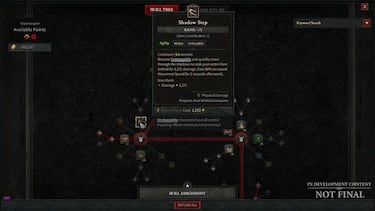
With a name like “Diablo” you know what you’re getting with the franchise. Grotesque demons, gothic temples, dark, dreadful environments, and all sorts of evil looking regalia spread all over the place. And while the previous games have had that (even when Diablo 3 was much brighter and colorful), this new entry is not messing around. We’re talking heavy gore, flesh explosions, torture, body horror, blood everywhere, people turning on each other and heavy graphic violence.
Diablo IV is absolutely not a game for children. As if this wasn’t obvious from the trailers, people die in horrible and gruesome ways all the time. One very short sidequest in the are we were allowed to roam in (Fractured Peaks) saw us helping a woman find her husband, who had run off with another woman into the woods. Expecting to only find them doing some adult rated stuff, what we were met with made us feel like we needed an adult ourselves: the man, bisected and flayed, hanging from chains from pillars in a trance begging for more, heavily detailed. Ok, we’re exaggerating a bit about needing an adult, but we mean it when we say this is some dark stuff and Blizzard is not holding back from showing off demonic rituals and gore.
Related stories
This grimdark tone is wonderfully accompanied by an amazing soundtrack that harkens back to the good old days of Diablo II. Sometimes as simple as a violin or a guitar plucking in the background with some accompanying drums, or droning sounds of howling winds and other environmental effects, the music helps everything feel oppressive and hopeless. It is dark and moody, and almost never overtakes the audio. Even in an unfinished build of the game, the ambiance sucks you right in and leaves you in a constant state of dread. You never know if you’re hearing distant screaming, or if it's the music messing with your head.
In case we haven’t made ourselves clear, Diablo IV is shaping up to be an impressive title. While we went into it admittedly doubtful due to past experiences with Diablo Immortal, we were met with incredibly polished mechanics, next level presentation, and a lot of hope for the future of this title. We can’t wait to see more of what the team at Blizzard Entertainment is doing with the franchise, and hopefully they stay true to their goals and managed to redeem the series after the predatory mess that was their mobile entry.